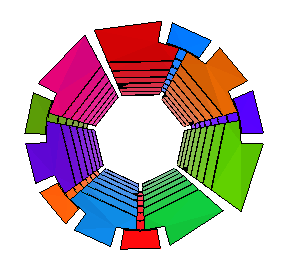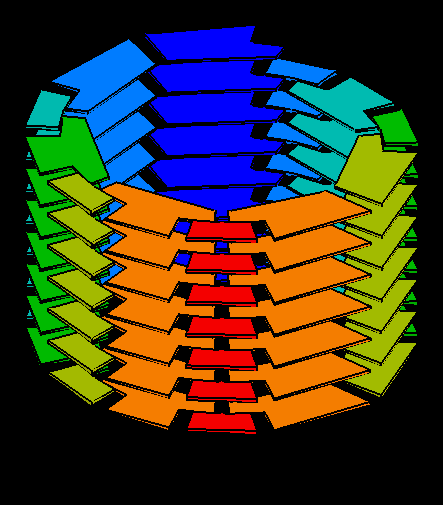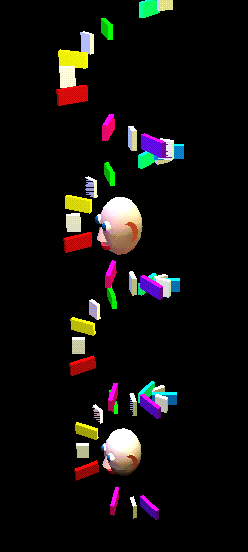
|

|
|
Discontinuous (spiraling) color wheel (color-complementing traditionally black keys) | Chromastereoptic rendering |
Inspired by the cyclical nature of octaves and helical structure of a
scale (Shepard, '82 and '83), we prepared a model of a piano-style keyboard
(prototyped in Mathematica), which was then geometrically warped into a left-handed
helical configuration, one octave/revolution,
pitch mapped to height.
The natural orientation of upper frequency keys higher on the helix
suggests a parsimonious left-handed chirality,
so that ascending notes cross in front of a typical listener left->right.
Our model is being imported (via the dxf file format) into
(Open Inventor/)VRML, where it can be
driven by MIDI events, realtime
or sequenced, which stream is both synthesized (by a Roland Sound Module),
and spatialized by a heterogeneous
spatial sound backend
(including the
Crystal River Engineering Acoustetron II
and the
Pioneer Sound Field Control speaker-array System),
so that the sound of the respective notes is
directionalized with respect to sinks, avatars of the human user, by
default in the tube of the helix.
This is a work-in-progress
which we hope to be fully functional within the next few months.

|

|
|
Discontinuous (spiraling) color wheel (color-complementing traditionally black keys) | Chromastereoptic rendering |

|
Perhaps the most exotic feature of the helical keyboard
is the ability to fork one's
presence (Cohen, '95; Cohen and Koizumi, '95),
replicating subject instead of object,
by installing multiple sinks at
arbitrary places around the virtual scene
so
that, for example, harmony and melody can be separately directionalized,
using two heads
to normalize the octave; such a technique effectively
doubles the helix from the perspective of a single listener.
Rather than a symmetric arrangement of the individual helices,
we perceptually superimpose them in-phase, coextensively,
so that corresponding notes in different octaves
are at the same azimuth.
(For instance,
a c4 melodic note and a collapsed c major chord (c2 + e2 + f2)
would both be at 12 o'clock.) |
 ; Copyright ©
2023, Jens Herder, All Rights Reserved.
; Copyright ©
2023, Jens Herder, All Rights Reserved.